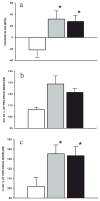A comparison of combination dopamine and epinephrine treatment with high-dose dopamine alone in asphyxiated newborn piglets after resuscitation
- PMID: 23344679
- PMCID: PMC4972577
- DOI: 10.1038/pr.2013.17
A comparison of combination dopamine and epinephrine treatment with high-dose dopamine alone in asphyxiated newborn piglets after resuscitation
Abstract
Background: When asphyxiated neonates require additional cardiovascular support to moderate doses of dopamine infusion, controversy exists on the differential hemodynamic effects of two approaches (adding a second inotrope vs. increasing dopamine dosage). We hypothesized that high-dose dopamine (HD) would be detrimental to systemic and regional perfusion as compared with dopamine and epinephrine (D + E) combination therapy using a swine model of neonatal hypoxia-reoxygenation (H-R).
Methods: Twenty-seven piglets (1-4 d, 1.5-2.5 kg) were used for continuous monitoring of systemic arterial pressure (mean arterial pressure, MAP) and pulmonary arterial pressure (PAP), cardiac output (cardiac index, CI), and carotid (carotid artery flow index, CAFI), superior mesenteric (superior mesenteric artery flow index), and renal arterial flows. H-R piglets underwent 2 h of hypoxia followed by 2 h of reoxygenation before drug infusion (2 h).
Results: The hemodynamics of H-R piglets deteriorated gradually after reoxygenation. HD and D + E infusions improved CI similarly (both groups vs. control; P < 0.05). Both regimens increased MAP (P < 0.05) but not PAP, with decreased PAP/MAP ratio in D + E piglets. Both regimens improved CAFI and superior mesenteric artery flow index, with decreased mesenteric vascular resistance in HD-treated piglets. No significant effect on renal perfusion was observed.
Conclusion: In H-R newborn piglets treated with a moderate dose of dopamine, adding epinephrine or further increasing dopamine improved systemic hemodynamics similarly; these treatments have differential effects on the pulmonary and mesenteric circulations.
Figures





Similar articles
-
The effects of dopamine and epinephrine on hemodynamics and oxygen metabolism in hypoxic anesthetized piglets.Crit Care. 2001;5(3):158-66. doi: 10.1186/cc1016. Epub 2001 Apr 26. Crit Care. 2001. PMID: 11353933 Free PMC article.
-
Milrinone is preferred to levosimendan for mesenteric perfusion in hypoxia-reoxygenated newborn piglets treated with dopamine.Pediatr Res. 2012 Mar;71(3):241-6. doi: 10.1038/pr.2011.48. Epub 2012 Jan 11. Pediatr Res. 2012. PMID: 22337258 Free PMC article.
-
Systemic and regional hemodynamic effects of high-dose epinephrine infusion in hypoxic piglets resuscitated with 100% oxygen.Shock. 2007 Oct;28(4):491-7. doi: 10.1097/shk.0b013e31804f77b8. Shock. 2007. PMID: 17577139
-
Epinephrine versus dopamine to treat shock in hypoxic newborn pigs resuscitated with 100% oxygen.Shock. 2008 Feb;29(2):262-8. doi: 10.1097/shk.0b013e31811ff509. Shock. 2008. PMID: 18386393
-
A blind, randomized comparison of the circulatory effects of dopamine and epinephrine infusions in the newborn piglet during normoxia and hypoxia.Crit Care Med. 1995 Apr;23(4):740-8. doi: 10.1097/00003246-199504000-00024. Crit Care Med. 1995. PMID: 7712765
Cited by
-
Cardiovascular Supportive Therapies for Neonates With Asphyxia - A Literature Review of Pre-clinical and Clinical Studies.Front Pediatr. 2018 Dec 10;6:363. doi: 10.3389/fped.2018.00363. eCollection 2018. Front Pediatr. 2018. PMID: 30619782 Free PMC article. Review.
-
Meconium Aspiration Syndrome, Hypoxic-Ischemic Encephalopathy and Therapeutic Hypothermia-A Recipe for Severe Pulmonary Hypertension?Children (Basel). 2024 Jun 1;11(6):673. doi: 10.3390/children11060673. Children (Basel). 2024. PMID: 38929252 Free PMC article. Review.
References
-
- The World Health Report 2005: Make every mother and child count. Geneva, Switzerland: WHO Press, World Health Organization; 2005. Newborns: no longer going unnoticed; pp. 79–101.
-
- Martín-Ancel A, García-Alix A, Gayá F, Cabañas F, Burgueros M, Quero J. Multiple organ involvement in asphyxia. J Pediatr. 1995;127:786–93. - PubMed
-
- Alonso-Spilsbury M, Mota-Rojas D, Villanueva-García D, et al. Perinatal asphyxia pathophysiology in pig and human: A review. Anim Reprod Sci. 2005;90:1–30. - PubMed
-
- Cheung PY, Johnson ST, Obaid L, Chan GS, Bigam DL. The systemic, pulmonary and regional hemodynamic recovery of asphyxiated newborn piglets resuscitated with 18%, 21% and 100% oxygen. Resuscitation. 2008;76:457–64. - PubMed
Publication types
MeSH terms
Substances
Grants and funding
LinkOut - more resources
Full Text Sources
Other Literature Sources
Research Materials

